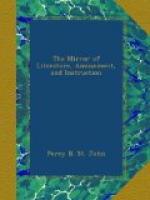[Illustration: (Percy’s Cross.)]
The second specimen (see the Cut) stands by the side of the highway over Hedgeley Moor, in the adjoining county of Northumberland. This Cross is a record of the War of the Roses. Here, in one of the skirmishes preliminary to the celebrated victory at Hexham (May 12, 1464), Sir Ralph Percy was slain, by Lord Montacute, or Montague, brother to the Earl of Warwick, and warden of the east marches between Scotland and England. His dying words are stated to have been, “I have saved the bird in my breast:” meaning his faith to his party. The memorial is a square stone pillar, embossed with the arms of Percy and Lucy: they are nearly effaced by time, though the personal valour of the hero is written in the less perishable page of history.
The Nevilles are distinguished personages in the pages of the historians of the North. In Durham they have left a lasting memorial of their magnificence in Raby Castle, the principal founder of which was John de Neville, Earl of Westmoreland; who, in 1379, obtained a license to castellate his manor of Raby; though a part of the structure appears to have been of more ancient date. Leland speaks of it in his time as “the largest castle of lodgings in all the north country.” It remains to this day the most perfect castellated mansion, or, more strictly, castle, in the kingdom, and its “hall” eclipses even the chivalrous splendour of Windsor: here 700 knights, who held of the Nevilles, are said to have been entertained at one time. The whole establishment is maintained with much of the hospitable glories of the olden time by the present distinguished possessor of Raby, the Marquess of Cleveland.
[6] See also pages 113 and 329 of the present volume.
[7] Hist. Scot. By Sir W. Scott, Bt., vol. i, p. 197.
[8] Ibid. p. 199.
[9] Faedera, tom. v. p. 542.
[10] Messrs Britton and Brayley—Beauties
of England and Wales,
vol. v. p. 199.
* * * * *
WINTER EXHIBITION OF PICTURES, AT THE SUFFOLK-STREET GALLERY.
(Concluded from page 231.)
144. Landscape and Figures. The first by Gainsborough; the latter by Morland.
145. The Body of Harold discovered by Swanachal and two Monks, the morning after the Battle of Hastings. A.J. Woolmer. A picture of some, and not undeserved, distinction in a previous exhibition.
150. Mr. King and Mrs. Jordan in the “Country Girl.” R. Smirke, R.A. The drawing is easy and natural, but the colouring appears to us deficient in tone and breadth.
153. View of the River Severn near the New Passage House. Nasmyth. A delightful scene in what we may call the artist’s best, or crisp style.
157. Puppy and Frog. E. Landseer, R.A. In the most vigorous style of our best animal painter.




